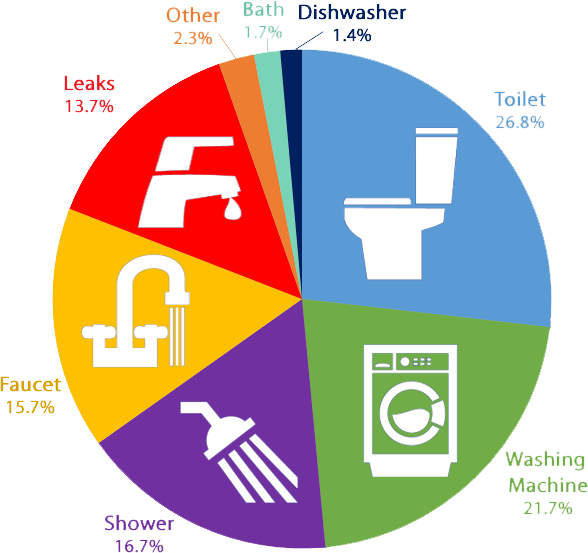Indoor Water accounts for about 40% of all water used in a residential home and can often be one of the easiest places to curb your usage, saving you money on your water bill. Simply turning the water off while brushing your teeth, making sure there is a full load when washing your clothes or dishes, or re-using a water glass can save thousands of gallons each year! Finding and fixing leaks early can also cut water use by as much as 13.7%! Explore the resources below for ways you can save.

Tips for Checking for Leaks in Your Home
Using Your Water Meter to Find a Leak
One of the quickest places to determine if you have a leak occurring in your home is at your water meter. After turning off all of the water in your home, if the water meter is still running, you will know there is a leak occurring.
- Before beginning, be sure to turn off all of the water both inside and outside of your home.
- Find the red needle on the face of the meter and note its location.
- Wait at least 15 minutes and look for the needle location again.
- If the needle has moved and you have turned all water sources off (ice maker, air conditioner, etc.), you may have a leak.
Checking a Toilet for Leaks
Did you know that replacing an older, inefficient toilet with a WaterSense labeled model can save 13,000 gallons per year and nearly $2,400 in water use and water waste over the lifetime of the toilet?
Toilets are regularly the most common source of leaks in a household and can often be the easiest to fix.
- Open the toilet tank located in the back of your toilet.
- Add dye tablets or a few drops of food coloring to the toilet tank.
- Do not flush the toilet for 15 minutes.
- Return to the toilet to see if there is any color in the main toilet bowl.
- If there is color in the bowl, you probably have a leak that will require additional investigation.
Since most toilet leaks are the result of a faulty flapper valve, below are a few steps for replacing the most common flapper types:
- Open the toilet tank located in the back of your toilet.
- Add dye tablets or a few drops of food coloring to the toilet tank.
- Do not flush the toilet for 15 minutes.
- Return to the toilet to see if there is any color in the main toilet bowl.
- If there is color in the bowl, you probably have a leak that will require additional investigation.